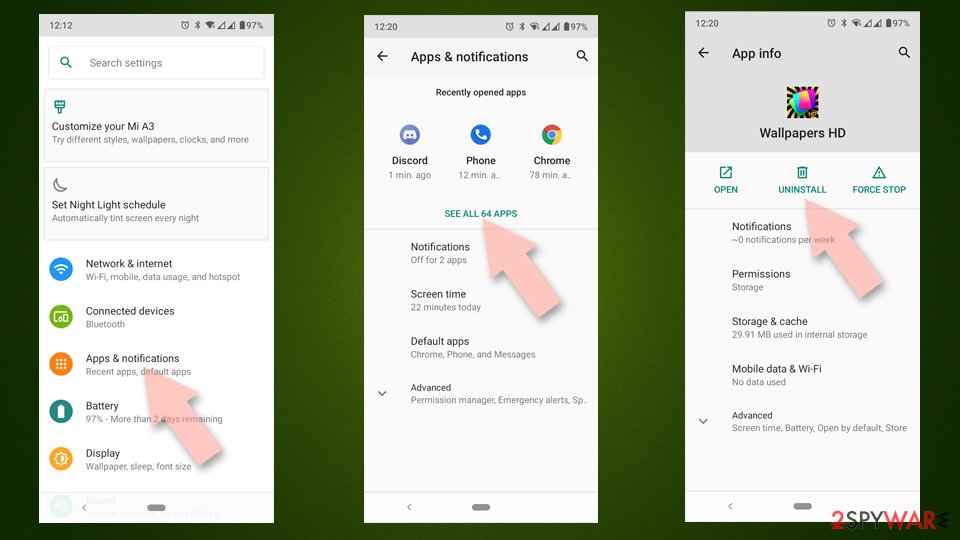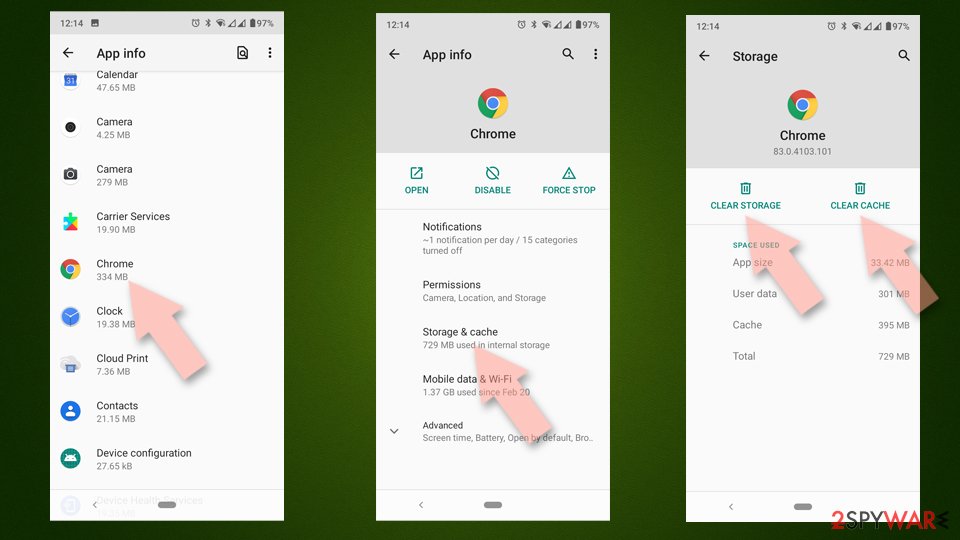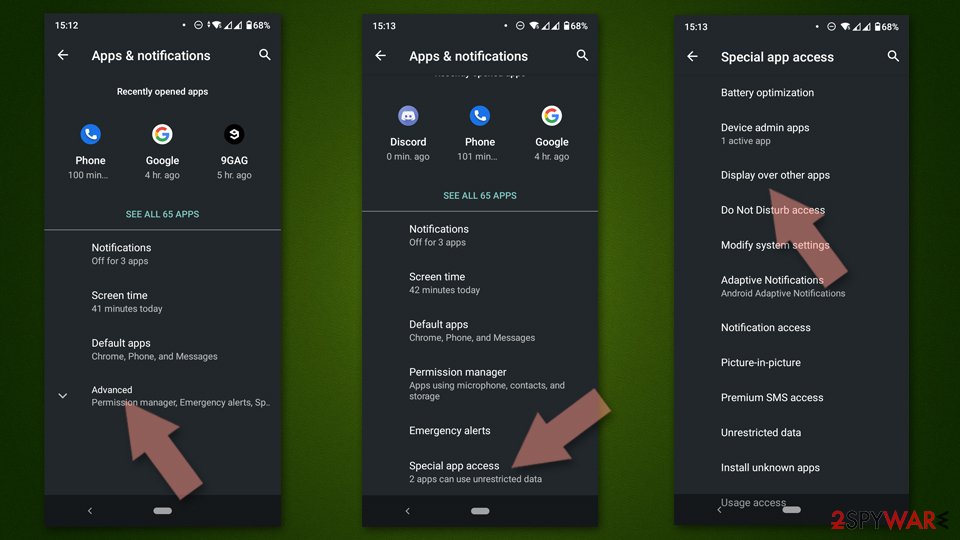Captcha-sourcecenter.com (Easy Removal Guide) - Virus Removal Instructions
Captcha-sourcecenter.com Removal Guide
What is Captcha-sourcecenter.com?
Captcha-sourcecenter.com – a shady website that users are forced to visit by adware infections

Captcha-sourcecenter.com is a dubious website developed for only one reason – show deceptive ads and redirect to affiliated pages. It does that by prompting visitors to subscribe to its notifications. This rogue site can do that by showing different messages, which depend on your geolocation.
You might see a prompt that urges you to press the Allow button to verify that you're not a robot, that you're over 18 years old, to close the window, to continue watching a video, and so on. Push notifications should only be accepted from legitimate sources, so please don't enable Captcha-sourcecenter.com notifications.
If you didn't type in the culprit's address manually into the URL bar, but the website is still opened, you have an adware infection on your device. The good news is that it can be easily eliminated with our guides posted at the bottom of this article. If you're eager to get rid of it – scroll down. If you want to learn more about potentially unwanted programs[1] (PUPs for short), keep reading.
| name | Captcha-sourcecenter.com |
|---|---|
| Type | PUP, adware, redirect virus |
| Purpose | Deceive visitors into enabling notifications to show ads and cause redirects to affiliated sites |
| Ip address | 5.8.34.165 |
| Symptoms | Ads popping up as notifications, redirects to questionable sites, slower device performance |
| Risks | Financial losses, other PUP installation, privacy issues, malware infections |
| Distribution | Fake Flash Player updates, freeware, deceptive ads |
| Removal | All infections, no matter how insignificant or severe, should be eliminated by using a trustworthy anti-malware tool |
| System health fix | PUPs and shady websites you're forced to visit leave many traces on your system directories and files. Resolve any system-related issues by running system diagnostics with the time-proven FortectIntego system repair tool |
Captcha-sourcecenter.com virus will display ads in the form of notifications as soon as you push the Allow button. They will be shown directly on your phone screen or the computer desktop. In some cases, the “X” button can't even be pushed, as either the ad won't close or an affiliated page opened as if you've clicked on the ad itself.
Captcha-sourcecenter.com ads are deceptive as they don't represent the sites you will be redirected to. The ads and the affiliated websites usually have nothing in common. The ads are made to be alluring, sometimes even irresistible, but they should never be clicked on.
But websites like Captcha-sourcecenter.com, including News-central.org, Therequire.biz, Eriodordedl.biz, and a myriad of others, have a way of forcing you to visit affiliated sites either way. They can cause sudden redirects, where new tabs with sponsored websites are opened out of the blue.
The worse thing is that the portals that Captcha-sourcecenter.com advertises might have various malicious intentions. Some might try to draw you into gambling, while others steal your private information (credit card details, SSNs, phone numbers, etc.) or download malware automatically through drive-by downloads.
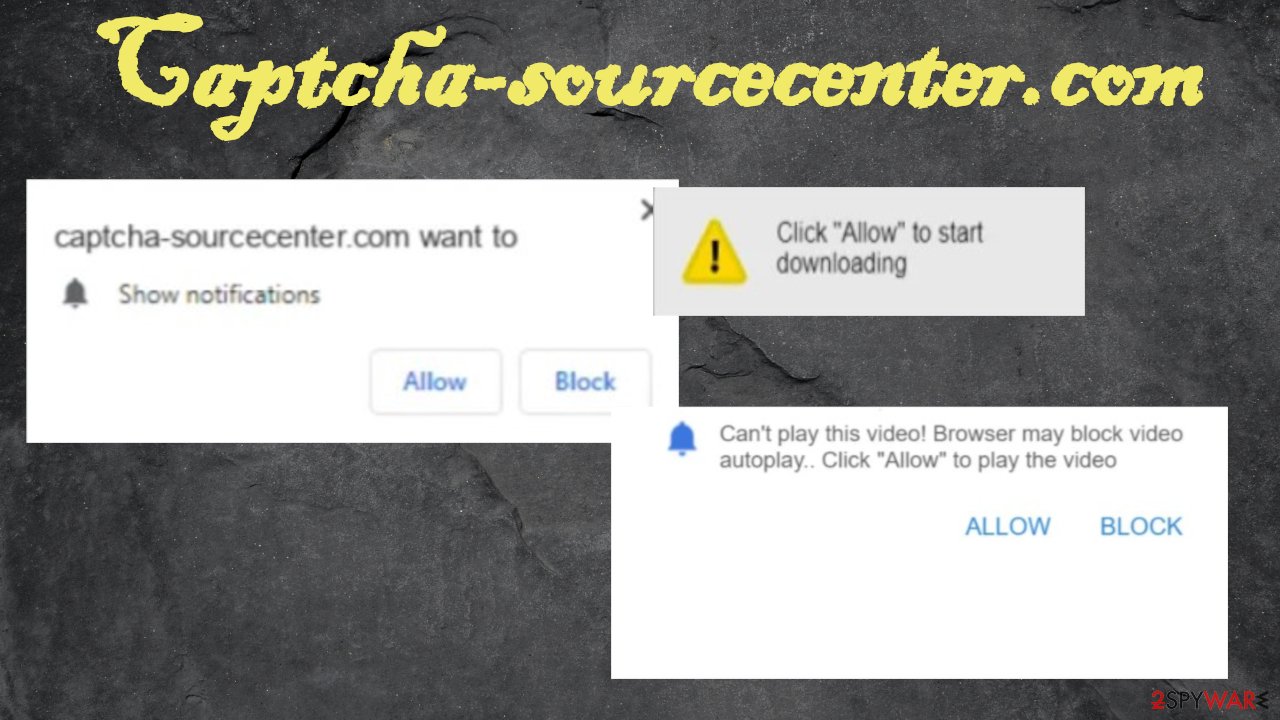
Thus although adware is categorized as a potentially unwanted program, it can become a gateway to more severe malware[2] infections, such as Trojans, ransomware, and alike. Therefore, you should remove Captcha-sourcecenter.com and any adware or other suspicious files immediately.
The best and easiest way to do that is by entrusting this task to reliable anti-malware software. Download free security tools such as SpyHunter 5Combo Cleaner or Malwarebytes, perform a full system scan, and let either of these AV tools do the rest. Afterward, run system diagnostics with the powerful FortectIntego system repair tool to finish Captcha-sourcecenter.com removal by eliminating any of its traces from the system files/settings.
Be observant when installing software from a bundle
People usually are puzzled about how did potentially unwanted programs get on their devices. Although there are many ways such junkware can be spread, one of the most popular PUP delivery techniques is through software bundles, i.e., packs containing installers for more than one app.
These bundles are usually downloaded from third-party software vendors, but lately, more and more app developers decide to earn a penny by adding additional apps to their downloads. Thus people should be aware of this, and they should stay alert when installing any new software.
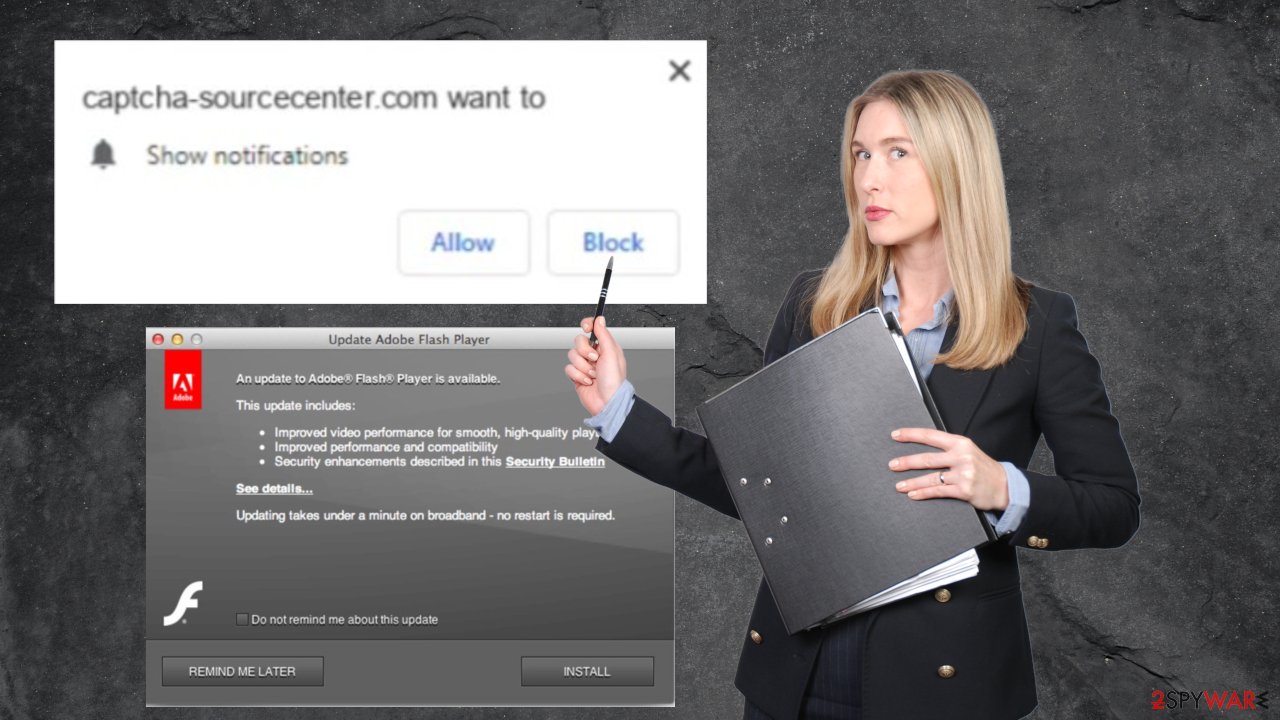
The easiest way to avoid PUPs is to choose the Advanced or Custom installation mode instead of the Recommended, Quick, Standard ones. Then go step-by-step and remove preselected ticks from all software that seems at least a bit suspicious, or you don't need it in the first place. If you're on the fence about any app, you can always do a web search or check if we haven't written about it.
Instructions to remove Captcha-sourcecenter.com virus quickly but safely
Push notifications are a legitimate service used by many websites to bring you the latest news, sports updates, sales, etc. But threat actors tend to misuse it by creating Captcha-sourcecenter.com virus and shady websites alike to deliver deceptive ads right to people's doorsteps.
In the future, please remember to accept notifications only from legitimate pages that you frequently visit. For now, remove Captcha-sourcecenter.com by scanning your device with a reliable anti-malware tool. Proper security software would block such pages and prevent such perils in the future.
If you've clicked the Allow button, use our Captcha-sourcecenter.com removal guides for browsers (Safari, Chrome, etc.) posted below, and you'll be done within minutes. IT experts[3] urge you to perform system diagnostics to keep your system files at bay and tracking cookies away.
You may remove virus damage with a help of FortectIntego. SpyHunter 5Combo Cleaner and Malwarebytes are recommended to detect potentially unwanted programs and viruses with all their files and registry entries that are related to them.
Getting rid of Captcha-sourcecenter.com. Follow these steps
Stop browser notifications
Remove unwanted notifications from Google Chrome (desktop):
- Open Google Chrome browser and go to Menu > Settings.
- Scroll down and click on Advanced.
- Locate Privacy and security section and pick Site Settings > Notifications.

- Look at the Allow section and look for a suspicious URL.
- Click the three vertical dots next to it and pick Block. This should remove unwanted notifications from Google Chrome.

Remove unwanted notifications from Google Chrome (Android):
- Open Google Chrome and tap on Settings (three vertical dots).
- Select Notifications.
- Scroll down to the Sites section.
- Locate the unwanted URL and toggle the button to the left (Off setting).

Remove unwanted notifications from Mozilla Firefox:
- Open Mozilla Firefox and go to Menu > Options.
- Click on Privacy & Security section.
- Under Permissions, you should be able to see Notifications. Click the Settings button next to it.

- In the Settings – Notification Permissions window, click on the drop-down menu by the URL in question.
- Select Block and then click on Save Changes. This should remove unwanted notifications from Mozilla Firefox.

Remove unwanted notifications from Safari:
- Click on Safari > Preferences…
- Go to the Websites tab and, under General, select Notifications.
- Select the web address in question, click the drop-down menu and select Deny.

Remove unwanted notifications from MS Edge:
- Open Microsoft Edge, and click the Settings and more button (three horizontal dots) at the top-right of the window.
- Select Settings and then go to Advanced.
- Under Website permissions, pick Manage permissions and select the URL in question.

- Toggle the switch to the left to turn notifications off on Microsoft Edge.

Remove unwanted notifications from MS Edge (Chromium):
- Open Microsoft Edge, and go to Settings.
- Select Site permissions.
- Go to Notifications on the right.
- Under Allow, you will find the unwanted entry.
- Click on More actions and select Block.

Remove unwanted notifications from Internet Explorer:
- Open Internet Explorer, and click on the Gear icon at the top-right of the window.
- Select Internet options and go to the Privacy tab.
- In the Pop-up Blocker section, click on Settings.
- Locate web address in question under Allowed sites and pick Remove.

Uninstall from Windows
Instructions for Windows 10/8 machines:
- Enter Control Panel into Windows search box and hit Enter or click on the search result.
- Under Programs, select Uninstall a program.

- From the list, find the entry of the suspicious program.
- Right-click on the application and select Uninstall.
- If User Account Control shows up, click Yes.
- Wait till uninstallation process is complete and click OK.

If you are Windows 7/XP user, proceed with the following instructions:
- Click on Windows Start > Control Panel located on the right pane (if you are Windows XP user, click on Add/Remove Programs).
- In Control Panel, select Programs > Uninstall a program.

- Pick the unwanted application by clicking on it once.
- At the top, click Uninstall/Change.
- In the confirmation prompt, pick Yes.
- Click OK once the removal process is finished.
Delete from macOS
Remove items from Applications folder:
- From the menu bar, select Go > Applications.
- In the Applications folder, look for all related entries.
- Click on the app and drag it to Trash (or right-click and pick Move to Trash)

To fully remove an unwanted app, you need to access Application Support, LaunchAgents, and LaunchDaemons folders and delete relevant files:
- Select Go > Go to Folder.
- Enter /Library/Application Support and click Go or press Enter.
- In the Application Support folder, look for any dubious entries and then delete them.
- Now enter /Library/LaunchAgents and /Library/LaunchDaemons folders the same way and terminate all the related .plist files.

Uninstall from Android
Uninstall unwanted programs from Android device:
- Go to Settings -> Apps/Applications.
- Expand the full list of the installed apps.
- Scroll through the list and tap on a suspicious application once.
- Tap on it and select Uninstall.

- Reboot the device.
Clear Storage and data files on Android from Google Chrome or other apps:
- Go to Settings > Apps/Applications.
- Expand the full list of the installed apps.
- Tap on Chrome and select Storage & cache.
- Clear storage and clear cache of the app.

If you are seeing ads on top of other apps but are not sure what is causing it, perform the following steps:
- Go to Apps/Applications.
- Tap Advanced.
- Select Special App access.
- Tap on Display over other apps.

- Eliminate apps with these access rights enabled.
Remove from Microsoft Edge
Delete unwanted extensions from MS Edge:
- Select Menu (three horizontal dots at the top-right of the browser window) and pick Extensions.
- From the list, pick the extension and click on the Gear icon.
- Click on Uninstall at the bottom.

Clear cookies and other browser data:
- Click on the Menu (three horizontal dots at the top-right of the browser window) and select Privacy & security.
- Under Clear browsing data, pick Choose what to clear.
- Select everything (apart from passwords, although you might want to include Media licenses as well, if applicable) and click on Clear.

Restore new tab and homepage settings:
- Click the menu icon and choose Settings.
- Then find On startup section.
- Click Disable if you found any suspicious domain.
Reset MS Edge if the above steps did not work:
- Press on Ctrl + Shift + Esc to open Task Manager.
- Click on More details arrow at the bottom of the window.
- Select Details tab.
- Now scroll down and locate every entry with Microsoft Edge name in it. Right-click on each of them and select End Task to stop MS Edge from running.

If this solution failed to help you, you need to use an advanced Edge reset method. Note that you need to backup your data before proceeding.
- Find the following folder on your computer: C:\\Users\\%username%\\AppData\\Local\\Packages\\Microsoft.MicrosoftEdge_8wekyb3d8bbwe.
- Press Ctrl + A on your keyboard to select all folders.
- Right-click on them and pick Delete

- Now right-click on the Start button and pick Windows PowerShell (Admin).
- When the new window opens, copy and paste the following command, and then press Enter:
Get-AppXPackage -AllUsers -Name Microsoft.MicrosoftEdge | Foreach {Add-AppxPackage -DisableDevelopmentMode -Register “$($_.InstallLocation)\\AppXManifest.xml” -Verbose

Instructions for Chromium-based Edge
Delete extensions from MS Edge (Chromium):
- Open Edge and click select Settings > Extensions.
- Delete unwanted extensions by clicking Remove.

Clear cache and site data:
- Click on Menu and go to Settings.
- Select Privacy, search and services.
- Under Clear browsing data, pick Choose what to clear.
- Under Time range, pick All time.
- Select Clear now.

Reset Chromium-based MS Edge:
- Click on Menu and select Settings.
- On the left side, pick Reset settings.
- Select Restore settings to their default values.
- Confirm with Reset.

Remove from Mozilla Firefox (FF)
Remove dangerous extensions:
- Open Mozilla Firefox browser and click on the Menu (three horizontal lines at the top-right of the window).
- Select Add-ons.
- In here, select unwanted plugin and click Remove.

Reset the homepage:
- Click three horizontal lines at the top right corner to open the menu.
- Choose Options.
- Under Home options, enter your preferred site that will open every time you newly open the Mozilla Firefox.
Clear cookies and site data:
- Click Menu and pick Settings.
- Go to Privacy & Security section.
- Scroll down to locate Cookies and Site Data.
- Click on Clear Data…
- Select Cookies and Site Data, as well as Cached Web Content and press Clear.

Reset Mozilla Firefox
If clearing the browser as explained above did not help, reset Mozilla Firefox:
- Open Mozilla Firefox browser and click the Menu.
- Go to Help and then choose Troubleshooting Information.

- Under Give Firefox a tune up section, click on Refresh Firefox…
- Once the pop-up shows up, confirm the action by pressing on Refresh Firefox.

Remove from Google Chrome
Delete malicious extensions from Google Chrome:
- Open Google Chrome, click on the Menu (three vertical dots at the top-right corner) and select More tools > Extensions.
- In the newly opened window, you will see all the installed extensions. Uninstall all the suspicious plugins that might be related to the unwanted program by clicking Remove.

Clear cache and web data from Chrome:
- Click on Menu and pick Settings.
- Under Privacy and security, select Clear browsing data.
- Select Browsing history, Cookies and other site data, as well as Cached images and files.
- Click Clear data.

Change your homepage:
- Click menu and choose Settings.
- Look for a suspicious site in the On startup section.
- Click on Open a specific or set of pages and click on three dots to find the Remove option.
Reset Google Chrome:
If the previous methods did not help you, reset Google Chrome to eliminate all the unwanted components:
- Click on Menu and select Settings.
- In the Settings, scroll down and click Advanced.
- Scroll down and locate Reset and clean up section.
- Now click Restore settings to their original defaults.
- Confirm with Reset settings.

Delete from Safari
Remove unwanted extensions from Safari:
- Click Safari > Preferences…
- In the new window, pick Extensions.
- Select the unwanted extension and select Uninstall.

Clear cookies and other website data from Safari:
- Click Safari > Clear History…
- From the drop-down menu under Clear, pick all history.
- Confirm with Clear History.

Reset Safari if the above-mentioned steps did not help you:
- Click Safari > Preferences…
- Go to Advanced tab.
- Tick the Show Develop menu in menu bar.
- From the menu bar, click Develop, and then select Empty Caches.

After uninstalling this potentially unwanted program (PUP) and fixing each of your web browsers, we recommend you to scan your PC system with a reputable anti-spyware. This will help you to get rid of Captcha-sourcecenter.com registry traces and will also identify related parasites or possible malware infections on your computer. For that you can use our top-rated malware remover: FortectIntego, SpyHunter 5Combo Cleaner or Malwarebytes.
How to prevent from getting adware
Stream videos without limitations, no matter where you are
There are multiple parties that could find out almost anything about you by checking your online activity. While this is highly unlikely, advertisers and tech companies are constantly tracking you online. The first step to privacy should be a secure browser that focuses on tracker reduction to a minimum.
Even if you employ a secure browser, you will not be able to access websites that are restricted due to local government laws or other reasons. In other words, you may not be able to stream Disney+ or US-based Netflix in some countries. To bypass these restrictions, you can employ a powerful Private Internet Access VPN, which provides dedicated servers for torrenting and streaming, not slowing you down in the process.
Data backups are important – recover your lost files
Ransomware is one of the biggest threats to personal data. Once it is executed on a machine, it launches a sophisticated encryption algorithm that locks all your files, although it does not destroy them. The most common misconception is that anti-malware software can return files to their previous states. This is not true, however, and data remains locked after the malicious payload is deleted.
While regular data backups are the only secure method to recover your files after a ransomware attack, tools such as Data Recovery Pro can also be effective and restore at least some of your lost data.
- ^ Potentially unwanted program. Wikipedia. The free encyclopedia.
- ^ Roger A. Grimes. 9 types of malware and how to recognize them. Cso. Security news, features and analysis.
- ^ Virusai. Virusai. Spyware news and security.















